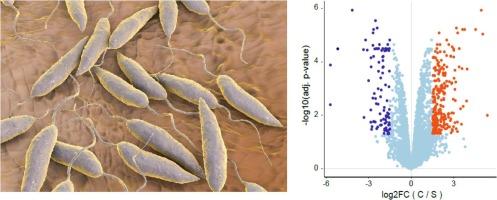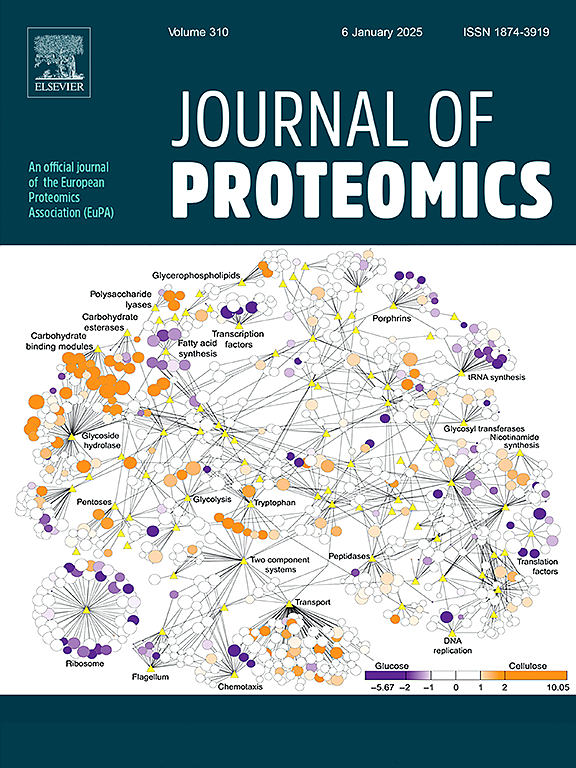Characterizing Leishmania infantum-induced resistance to trivalent stibogluconate (SbIII) through deep proteomics
IF 2.8
2区 生物学
Q2 BIOCHEMICAL RESEARCH METHODS
引用次数: 0
Abstract
Leishmania infantum belongs to the L. donovani complex, which includes species associated with visceral leishmaniasis. Traditionally, antimonial compounds have served as the primary antiparasitic treatment for all clinical forms of leishmaniasis. However, the global spread of resistance to these compounds has posed a significant challenge in the treatment in some regions. In this study, we aimed to investigate resistance to trivalent sodium stibogluconate in vitro using promastigotes from a wild strain of L. infantum. We compared the growth rates and proteomic profiles of wild-type and resistant line conducting label-free quantitative mass spectrometry-based proteomic analyses. Statistical and bioinformatics analyses were employed to evaluate the significance of protein concentration changes, protein identity annotation, GO term analysis, biosynthetic pathways, and protein-protein interactions. Our findings revealed that the resistant line displayed a notable reduction in growth rate. Proteomic data unveiled similar protein concentrations per cell in both groups but with differing molecule copy numbers. We identified 165 proteins with increased concentration, these were associated with transcription and translation activities, lipid metabolism, energy metabolism, and peroxisome biogenesis. In the decreased protein groups were 56 proteins linked to metal acquisition and metabolism, particularly iron. These results suggest a novel perspective on antimonial resistance, highlighting the importance of post-transcriptional and post-translational regulation, alongside energy expenditure compensation and alterations in organelle membrane lipid composition in antimonial-resistant parasites. Overall, our study provides insights into the proteomic profile of stibogluconate-resistant strain, contributing to our general understanding of the complex landscape of antiparasitic resistance in L. infantum.
Significance
Species within the Leishmania donovani complex are implicated in cases of visceral leishmaniasis in the world. Leishmania infantum is a species that predominates in regions spanning the Mediterranean Basin, the Middle East, Central Asia, South and Central America. Antimonials were the first treatment for leishmaniasis, however in the last decades, the resistance has emerged in subregions like India, where it is not a therapeutic option. In contrast, sodium stibogluconate (SbIII) remains the first-line treatment in the Americas. Unfortunately, the emergence of resistance has outpaced the development of new therapeutic options, thereby becoming a critical point in the struggle against the disease. In this study we performed an in-depth proteomic analysis with liquid chromatography mass-mass spectrometry (LC-MS/MS) on L. infantum with Sb-induced resistance in vitro. Results showed a complex proteomic adaptation in the resistant line, involving transcriptional and translational proteins, energy compensation, and homeostasis maintenance. These insights contribute to understanding the molecular adaptation in the parasite and provide information to new investigations related to therapeutics development.

通过深层蛋白质组学分析婴儿利什曼病诱导的对三价葡糖酸盐(SbIII)的抗性。
婴儿利什曼原虫属于多诺万利什曼原虫复合体,其中包括与内脏利什曼病有关的物种。传统上,抗柠檬醛化合物是治疗所有临床形式利什曼病的主要抗寄生虫药物。然而,这些化合物的抗药性在全球范围内蔓延,给某些地区的治疗带来了巨大挑战。在这项研究中,我们利用一种幼年利什曼病野生菌株的原生体,旨在体外研究对三价斯地伯葡酸钠的抗药性。通过无标记定量质谱蛋白质组分析,我们比较了野生型菌株和抗性菌株的生长速度和蛋白质组概况。我们采用了统计和生物信息学分析方法来评估蛋白质浓度变化、蛋白质标识注释、GO术语分析、生物合成途径和蛋白质-蛋白质相互作用的意义。我们的研究结果表明,抗性品系的生长速度明显下降。蛋白质组数据显示,两组细胞的蛋白质浓度相似,但分子拷贝数不同。我们发现有 165 个蛋白质浓度增加,这些蛋白质与转录和翻译活动、脂质代谢、能量代谢和过氧化物酶体生物生成有关。在蛋白质减少的群体中,有 56 个蛋白质与金属获取和代谢有关,尤其是铁。这些结果从一个新的角度揭示了抗锑酸盐寄生虫的抗性,强调了转录后和翻译后调控以及能量消耗补偿和细胞器膜脂质组成改变在抗锑酸盐寄生虫中的重要性。总之,我们的研究提供了对士的葡糖酸盐抗性菌株蛋白质组概况的见解,有助于我们全面了解婴儿痢疾杆菌抗寄生虫性的复杂情况。意义:世界各地的内脏利什曼病病例都与唐氏利什曼原虫复合体中的物种有关。婴儿利什曼原虫主要分布在地中海盆地、中东、中亚、南美洲和中美洲。抗睾酮类药物是治疗利什曼病的首选药物,但在过去几十年中,印度等次区域出现了抗药性,抗睾酮类药物已不再是治疗利什曼病的首选药物。相比之下,在美洲,斯地巴葡萄糖酸钠(SbIII)仍然是一线治疗药物。不幸的是,抗药性的出现已经超过了新治疗方案的开发速度,从而成为抗击疾病的关键点。在这项研究中,我们利用液相色谱-质谱联用技术(LC-MS/MS)对体外 Sb 诱导抗药性的婴儿鹅膏菌进行了深入的蛋白质组分析。结果表明,抗性品系的蛋白质组适应性非常复杂,涉及转录和翻译蛋白、能量补偿和平衡维持。这些见解有助于了解寄生虫的分子适应性,并为与治疗药物开发相关的新研究提供信息。
本文章由计算机程序翻译,如有差异,请以英文原文为准。
求助全文
约1分钟内获得全文
求助全文
来源期刊

Journal of proteomics
生物-生化研究方法
CiteScore
7.10
自引率
3.00%
发文量
227
审稿时长
73 days
期刊介绍:
Journal of Proteomics is aimed at protein scientists and analytical chemists in the field of proteomics, biomarker discovery, protein analytics, plant proteomics, microbial and animal proteomics, human studies, tissue imaging by mass spectrometry, non-conventional and non-model organism proteomics, and protein bioinformatics. The journal welcomes papers in new and upcoming areas such as metabolomics, genomics, systems biology, toxicogenomics, pharmacoproteomics.
Journal of Proteomics unifies both fundamental scientists and clinicians, and includes translational research. Suggestions for reviews, webinars and thematic issues are welcome.
 求助内容:
求助内容: 应助结果提醒方式:
应助结果提醒方式:


